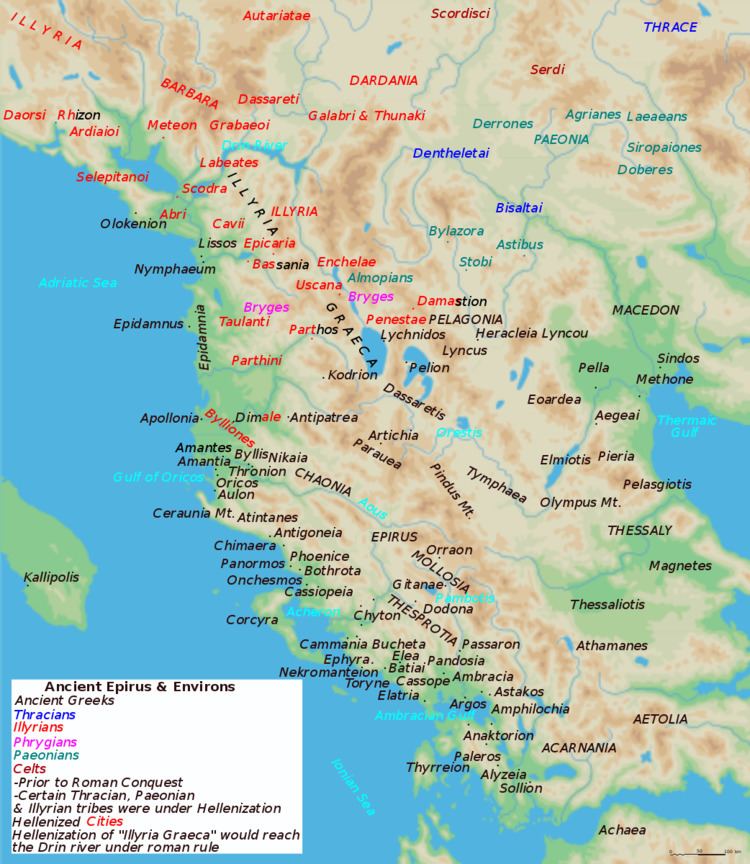 | ||
Similar Chaonians, Illyrians, Atintanians | ||
The Autariatae or Autariates were an ancient people that eventually became the most powerful Illyrian tribe.
Contents
History
Greek mythology attributes a progenitor to the Autariatae, son of Illyrius called Autarieus (Ancient Greek: Αὐταριεύς).
The Autariatae communities unified into a single political entity during the late 6th century BC. They began to expand eastward into territories controlled by the Triballi. Moreover, they expanded southward where they defeated the Ardiaei, their old rivals, in struggles for control over pastures and salty springs. Activities of the Autariatae at the turn of the 6th and 5th centuries BC profoundly influenced the peoples who were directly affected by their expansion. The Ardiaei were moved toward the coasts and the Triballi to the east. The expansion of the Autariatae enabled them to achieve hegemonic control over one part of the interior of the Balkan Peninsula. The leading class of the Autariatae society reached the peak of its political and economic development indicated through many great luxurious royal tumuli and graves created during the 5th century BC. Strabo’s comment on the Autariatae as "the once greatest and most powerful Illyrian people" most likely refers to this period. Their peak of development was followed by the gradual decline of the Autariatae ending in 310 BC with their sudden disappearance due to Celtic migrations.
Appian (95 – 165) writes that the Ardiaei were destroyed by the Autariatae and that in contrast to the Autariatae had maritime power. The ancient geographer, Strabo, lists the Autariatae as one of the three strongest tribes - the other two being the Ardiaei and the Dardanii.
TheAutariatae and the Celtic Scordisci are thought to have merged into one tribe in the Lower Morava valley, after 313 BC, since excavations show that the two groups made burials at the same exact grave field in Pecine, near Kostolac. Nine graves of Autariatae dating to 4th century BC and scattered Autariatae and Celtic graves around these earlier graves show that the two groups mixed rather than made war and this resulted in the lower Morava valley becoming a Celto-Thraco-Illyrian interaction zone.
Cultural practices
A standard practice of the Autariatae entailed killing their weak and wounded. This was meant to prevent meek individuals from falling into the hands of enemy tribes.
The Autariatae left a legacy of material wealth. So far, more than 100 castle ruins were identified to have been inhabited by the Autariatae, as well as thousands of tumuli in which they had been buried. Movable materials (mostly jewelry and weapons) reveal all specific features associated with the ethno-cultural originality of the Autariatae. The Autariatae established a continuous tradition of manufacturing metal and ceramic products. Artifacts consisting of metal sheets with luxurious golden and silver belts of Mramorac type indicate the complexity of this tradition.
The Autariatae are a classic example of a "highland" people who also show all the characteristics of a "highland" mentality (i.e. preservation of old beliefs). Case in point, the Autariatae have strongly maintained their burial customs of burning the dead in tumuli, which did not change until the end of the Glasinac culture. Archaeological remains indicate that the religious life of the Autariatae was influenced by both their ancestor cult and the cult of their solar god. One can find the numerous evidence of the solar cult throughout the territories once controlled by the Autariatae. The Autariatae economy was based on cattle breeding, metalwork, handicraft and trade. Because of its need for Greek and Italic goods, this Illyrian tribe was one of the biggest trade partners of the western and central Balkans to both Greek and Italic traders between the 7th and 6th centuries BC.
